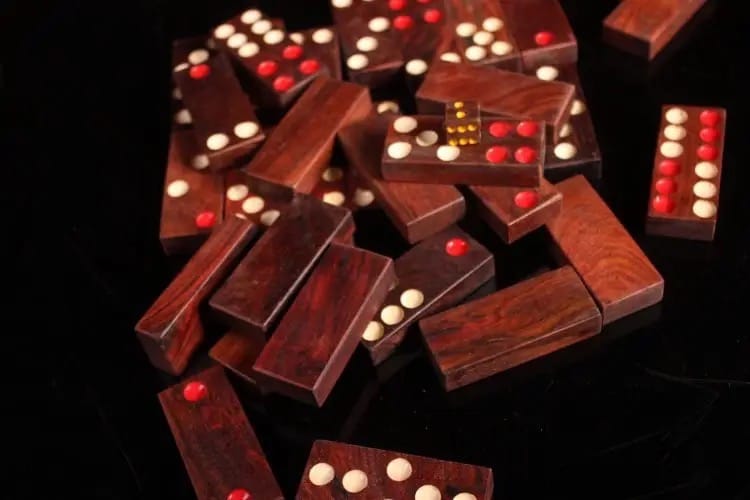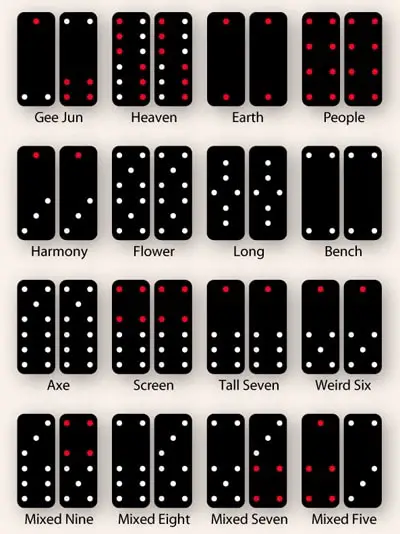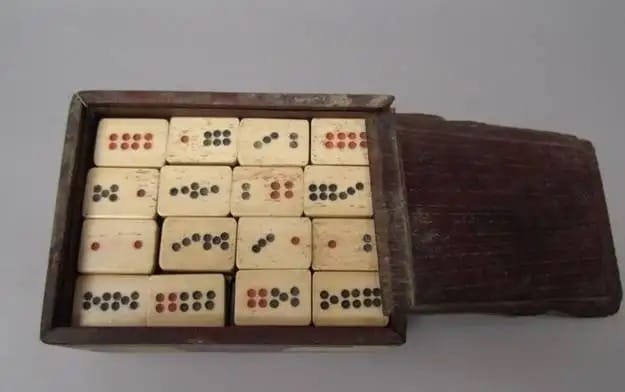The Chinese name given to ‘Chinese Dominoes’ is K’wat Pai, meaning “bone tablets”. The dominoes are used in various tile-based games like Tien Gow, Pai Gow, Tiu U and Kap Tai Sha which are traditional Chinese domino games. The first citation of the dominoes in China dates from 1120 AD. European travelers reported encounters with the dominoes during the Renaissance. Chinese dominoes are very different from the Western dominoes and the only similarity is the relationship to the dice used in their cultures.
What is dominoes game called

A domino is a flat block, rectangular in shape used as a gaming item. They are made of hard materials like wood or plastic and have marks on one side and blank on the other side. These marks are spots known as “pips”. The marked sides are divided by a line into two squares. The dominoes originated from China and they represent one of the ancient items for playing games. The pips represent the outcome of throwing two six-sided dice. The dominoes make up a domino set also called a pack or deck. A dominoes game is played with these dominoes.
A dominoes game can be played by 2 to 8 players. If there are 4 players you can choose to play as partners with the opposite player or you can each play individually. You need a flat playing space like a table and a pencil and paper. The simplest dominoes game requires 2 participants and a double-six set. The original domino set has one unique piece for each possible combination of two, with 0 to 6 spots and this is called a double-six set because the highest value piece has 6 pips on each end. If there are more than 3 players, you will need the double 9, 12, 15, or 18 sets.
How do you play Chinese dominoes

As mentioned earlier, Chinese dominoes vary from Western dominoes in terms of the number and distribution of the tiles and the games played with them. In the Chinese dominoes, a set consists of 32 tiles of a double-six pattern, allocated in two copies of; 1-1, 1-3, 1-5, 1-6, 2-2, 3-3, 4-4, 4-6, 5-5, 5-6 and 6-6 and one copy of; 1-2, 1-4, 2-3, 2-4, 2-5, 2-6, 3-4, 3-5, 3-6 and 4-5. The pips for 1 and 4 are red and the rest are white except 6 which is half-half. These colours are crucial in Chinese games.
The tiles are categorized into two “suits”; a military suit and a civilian suit. To play the Chinese dominoes game, you have to memorize them to know which tile belongs to which suit.
The civilian suit is comprised of twenty-two tiles, 2 sets of 11 distinct tiles. Each tile has a name analogous to a Chinese cultural or philosophical symbol. The dice are positioned according to these names and not their numbers. They are ranked in the following order; 6-6 is heaven, 1-1 is earth, 4-4 is man, 1-3 is the goose, 5-5 is plum flowers, 3-3 is long threes, 2-2 is the bench, 5-6 is axe head, 4-6 is redhead ten, 1-6 is the long leg seven and 1-5 is the bighead six.
The military suit is comprised of the remaining tiles in the set. Here, the tiles are named and positioned according to the combined number of pips on both ends of the tile. The outlier is the three and six which are individually counted. Sometimes, they may be combined to create a third suit called the “supreme suit”.
The game is dealt from a “woodpile” which is a row of grouped dominoes. The height of the woodpile is different depending on the game and the dealer is decided by rolling one or more dice. The game proceeds anti-clockwise from the dealer.
Chinese dominoes history
Traditional Chinese domino sets were made of black tiles with red and white dots. Blank tiles existed in China in the 17th century and it was these kinds of dominoes that made their way to Europe in the 18th century, initially to Italy.
Dominoes originated from China and the earliest mention of dominoes comes from the text Former Events in Wulin written by Zhou Mi somewhere between 1232 and 1298 in the Yuan Dynasty. In the text, he referred to ‘pupai’ (dominoes) and dice as objects being traded during Emperor Xiaozong’s reign between 1162 and 1189.
The modern game made its way to Italy in the 18th century. It is believed the Italian missionaries brought the game to Europe. After appearing in Italy, the game proceeded to France where it became famous. In the late 18th century, dominoes arrived in Britain with the help of the French war prisoners. One theory suggests that the game gained its present-day form in the Dominican Republic.
Another theory suggests that the game got its name from the French word “Domino” which alludes to the black and white hoods worn by French Christian priests during winter.
Who invented dominoes

In keeping with the current heritage among the Chinese labourers in the US, dominoes were created by Hung Ming to entertain his soldiers and keep them awake during the night watches in their camps.
Some give credit to Keung t’ai Kung and others to Fan Lai.
Dr Gustar Schlegel states that dominoes were conceived in 1120 AD by a statesman who showed them to Emperor Hwui Tsung. The game together with its explanation was locked in the imperial treasury and was first used during the reign of the emperor’s son, Kao-Tsung.
Mr. Chatto also cites the Ching tsz’ tung; the great Chinese dictionary saying that the cards now known in China as the “dotted cards” were created during the reign of Siuen-ho, in 1120 and became common during Kao-Tsung’s reign.
Conclusion
Historical evidence is inconclusive as to the exact inventor of the dominoes. The history of all games seems to be a continuous change rather than direct creation. What is certain is that the dominoes were invented and originated in China.
Currently, various versions of the game are played worldwide. Even though the game originated in China, it is famous in Latin America, especially in the Caribbean region.